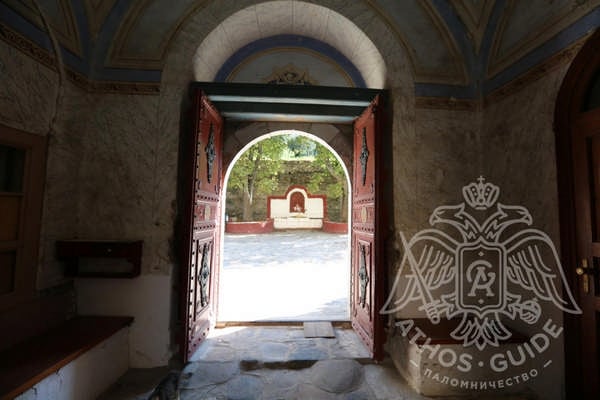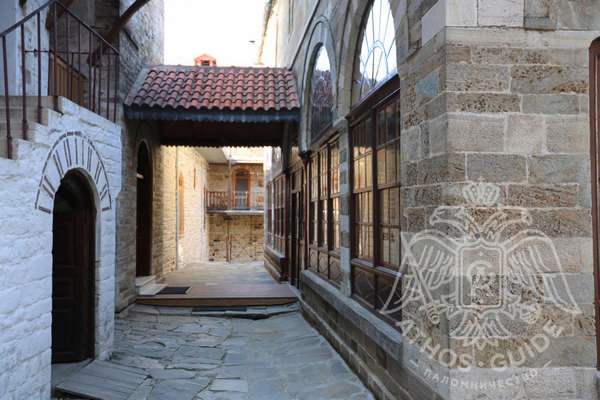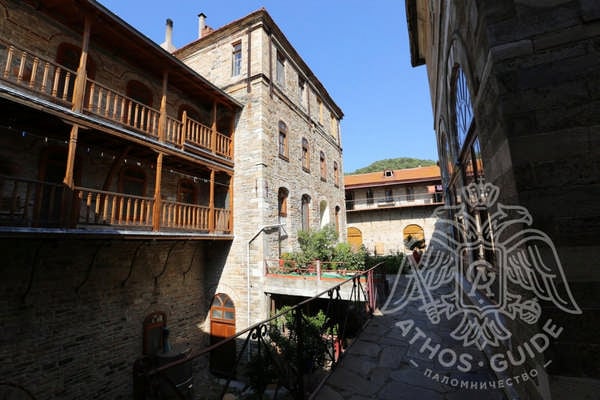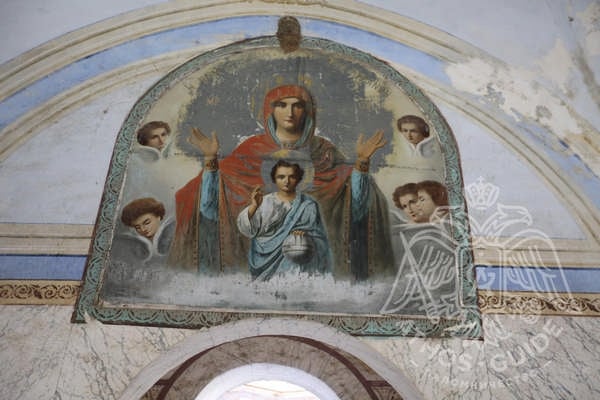History and present days

Location and Presence in the Athonite Peninsula
The road from the arsanas ascends towards the inside of the west coast and leads to the Konstamonitou Monastery, which is located on the southwestern slope of the mountain Kriovouni. In a place with rich and dense vegetation, it follows a stream that flows from east to west and joins the stream that descends from the Zograf Monastery.
The ground plan of the Konstamonitou Monastery has a quadrilateral shape. On the wings there are porches corresponding to the towers. The roofs of the wings are covered with tiles, except for the domes of the chapels.
The Athonite fathers practice the philosophical "λάθε βιώσας" [live unnoticed]. They refuse the secular state and its funds. The monastic community succeeds in that way to retain the appearance that the Athonite monasteries used to have in the 1950s.
Chimneys peek out of the windows while the kitchen runs on firewood. The Kathisma of the Holy Trinity, built in the late 19th century by the monk Paisios, is now a wreck just before the monastery to the west, on the road to the arsanas. Its condition gives the visitor a sense of abandonment. However, the monastery doesn’t lack livelihood. In the telephone booth, opposite the entrance, there is a wooden box full of empty telecards. In the past, there weren’t many pilgrims and visitors, since the monastery was almost forgotten. Lately, the decrease of the number of visitors accepted to other monasteries due to renovation projects, has led to an increase of the number of visitors accepted to the Monastery of Konstamonitou, making the monks feel awkward, as they weren’t used to such conditions.
History
Many legends are associated with the Konstamonitou Monastery. According to one theory, it was founded by Constantine the Great and completed by his son Consta. It therefore took their name. Later on, returning from Patras and Thebes with the relics of the holy Apostles Peter and Luke, Saint Artemios stopped in the area and built the first katholikon, which was one of the three oldest churches in Mount Athos (the other two are the katholikon of Saint Demetrios in the Holy Monastery of Vatopaidi, built by the relatives of the Great Martyr, and the church of Saint John the Forerunner in the Holy Monastery of Iviron). According to another version, the name of the monastery comes from a monk who came from Kastamoni of Paphlagonia in Asia Minor (hence the alternative name that was attributed to the monastery).
The earliest written references to the monastery date back to the 11th century. In 1097, its abbot was Hilarion, a relative of the Emperor Alexios I Komnenos. In 1276 the monastery was burnt down by latin defenders who followed the teachings of the Patriarch Vecchus and Michael VIII Palaiologos. Documents of the 14th century refer to court battles over land disputes with the Monastery of Esphigmenou, which was eventually awarded the land. During the reign of Andronicus II Palaiologos, the princess of Serbia, Anna Philanthropini, donated to the monastery a smaller structure dedicated to Saint Anthony. In the 3rd Typikon of Mount Athos (during the 14th century), the monastery is in the 16th place, out of 25 monastic communities. Additionally, it was burned and renovated in 1433 at the expense of the Serbian commander-in-chief Radic, who became a monk and took the name Romanos. During the Ottoman rule, the monastery barely managed to cope with heavy taxation, while its financial state was so difficult that the Metropolitan Joseph of Samos, who visited the place in 1666, found only six monks still living in the Monastery of Konstamonitou. In 1717 the east wing was burnt down and rebuilt by the monk Anthimos in 1728. In 1799, the Ecumenical Patriarch Neophytos VII restored the monastery to the cenobitic system with monk Gabriel as abbot and spiritual father of the community.
Due to lack of funds, the change in the organization of the monastery was not carried out until 1818. A large part of the north wing was renovated with the assistance of Vasiliki, the Christian wife of Ali Pasha of Ioannina. The renovation continued in the second half of the 19th century during the reign of Simeon, who also built the katholikon that is still located in the center of the monastery.
In the Monastery of Konstamonitou lived the holy young martyr Paul of Ioannina, who was martyred in Thessaloniki in 1821.

.jpg)







